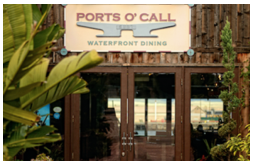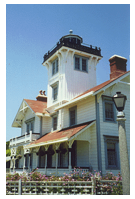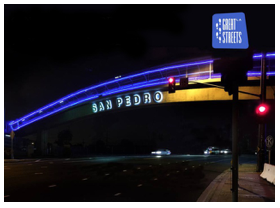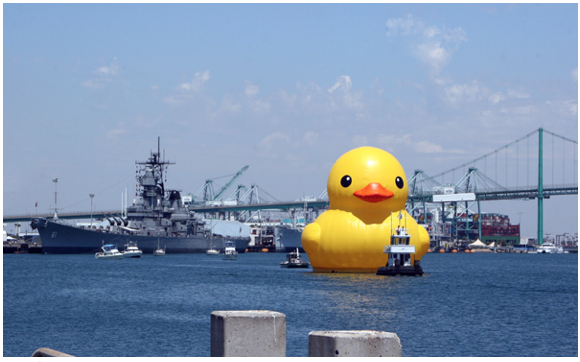CommentsTHE CHAPMAN REPORT--“Remember when we had all that fun here and we went to Ports O’ Call?” my sister recalled recently at one of our very last dinners at our cozy San Pedro house. “Remember we watched the boat parade and had drinks over at the Oyster Wharf? Remember? “We used to have so much fun in San Pedro.”
“We did!” nodded her friend Val, playing with a curl in her hair while recalling those adventurous days which would soon be our last.
Leslie and Val were here -- my sister from San Diego and her friend from Santa Monica—because time was short. We were preparing to leave our humble San Pedro digs after being rooted here for more than 30 years, a place I thought I might stay for the rest of my life, a place I loved from the moment I came, a place I called home.
 When I first came to the sleepy backwater village, the southernmost end of the road and so different from anywhere else in the city of the angels, my mind was captivated by its European flavor, the giant tanker ships gliding by, vessels bobbing in its harbors, the two stunning lighthouses, the towering golden cliffs, the fishing vessels that clung to the harbor’s inlets, the windsurfers speeding out on the waves. It seemed to be its own small city within the city of Los Angeles, thriving with a healthy heartbeat and a place to feel proud. We welcomed our friends by the barrelfuls to sail in the harbor in our small sloop, eat at a myriad of good restaurants and shop at the mom-and-pop stores at Ports O’Call: the cheese shop, the candy store, the collector’s store. My parents came. My friends came. Our relatives from England and Vancouver came.
When I first came to the sleepy backwater village, the southernmost end of the road and so different from anywhere else in the city of the angels, my mind was captivated by its European flavor, the giant tanker ships gliding by, vessels bobbing in its harbors, the two stunning lighthouses, the towering golden cliffs, the fishing vessels that clung to the harbor’s inlets, the windsurfers speeding out on the waves. It seemed to be its own small city within the city of Los Angeles, thriving with a healthy heartbeat and a place to feel proud. We welcomed our friends by the barrelfuls to sail in the harbor in our small sloop, eat at a myriad of good restaurants and shop at the mom-and-pop stores at Ports O’Call: the cheese shop, the candy store, the collector’s store. My parents came. My friends came. Our relatives from England and Vancouver came.
All seemed well in San Pedro --- at least in those days. But after living here for so many years, I noticed with dread that San Pedro seems to not have moved forward, but backward and this makes me very sad. It makes me sad to hear from old timers how gorgeous San Pedro used to be and the echo of the many losses we’ve had economically along with our difficult dealings with the city of Los Angeles who controls pretty much everything.
We’ve long since lost all the wonderful classic dinner restaurants, such as Ante’s, Cigo’s, Olsen’s, Savage Court as well as little places like Nosh and Mishi’s Strudel Bakery. They’re gone for a variety of reason—including the Great Recession and from the complicated task of running a business in Los Angeles. Many other businesses have shuttered and vanished because it is so hard to run a business in this former fishing village of 80,000. Rebirthing efforts failed repeatedly despite all the good intentions.
San Pedro should be a city of its own merit. Initially, it was that way, but in 1909, and because of the lucrative international port, San Pedro was snapped up officially by the city of Los Angeles which took away our freedom to beautify and make San Pedro great, the way we see fit. We are governed by two giant entities, the city of Los Angeles and its international harbor. The Port of Los Angeles is one of the biggest in the world with an adopted $1.2 billion budget. This giant often doesn’t make the best neighbor and could seem to care less about us down here trying to remain beautiful and relevant and keep our historic European charm built on the backs of Italian and Croatian immigrants along with a burgeoning Latino community. We lost so much, but in particular, we lost Ports O’Call, which seemed to me the heartbeat of the community when I arrived.
Since we don’t get to run our lives, residents here spend inordinate amounts of time battling to keep what we have. The work seems endless and tremendous and being done for free by the good souls who step up to the plate. Some adopt a project and then give it their all; others serve on one of our three Neighborhood Councils, their work cumbersome, long and rooted in struggle.
Because our lives seem limited, we, like other parts of the city such as Wilmington and Harbor City, are caught up in the massive grip of the big city and its port, so things like this happen:
We suddenly lost major thoroughfares across San Pedro for unnecessary bike lanes that the city unexpectedly installed on Western and Westmont Avenues, 25th Street and Pacific Avenue and are working toward adding more. People were angry, understandably so, because the bike lane project stripped away entire boulevards on heavily trafficked streets leaving commuters crawling to get to work and parents struggling to pick up their kids from school on time. Few of us knew the city even had a Bike Plan and many San Pedro leaders said they too were caught unaware. It’s a nice idea, the thought of getting more bikers on the street to reduce air pollution and get cars off the road, but with the steep terrain of our community and the jarring distances, it makes no sense. Most people live too far away to commute by bike, are disabled or have families they need to rush home to take care of. Logistically, it’s just not possible for most people to ride bikes to work.
The bike riders have yet to materialize in any significant number and probably never will, because beyond the long commute time, when you get there you’re doused in sweat and need to take a shower all over again. Residents in other areas of the city are protesting similar bike lanes because of the tremendous traffic woes. City officials explain it away by saying the lanes are here to stay and it’s just trying to fall into line with state legislation that was passed by then Governor Arnold Schwarzenegger. But perhaps the city should have started with the people who know best – local residents and not just bicycle lobbyists and state officials.
Over the years of living here, I learned residents needed to battle for just about everything to keep what we have and for any potential upgrades. If they didn’t, we’d get nothing.
Because so many decisions are made downtown and with only one council member out of 15 representing us, it seems difficult to line up local residents’ desires with those of city planners. Our wishes aren’t necessarily in tune with the city or the port, so people have simply taken matters in their own hands and worked diligently to salvage and restore what we have.
For instance, resident Allan Johnson and Gary Dwight formed the Cabrillo Beach Boosters Club, lobbied for years to get a $1.8 million revamp for our aging Angels Gate Lighthouse, an octagonal structure that since 1913 has guided boats into our harbor, and yep, that includes the many giant container ships doing business with the port. The port paid for it, but not out of the goodness of its heart. The funds came from the port’s community advisory committee due to a settlement over the expansion of China Shipping Co. Had there been no Allan Johnson and Gary Dwight, I cringe to think where the lighthouse would be now. Because of these people, it was restored in 2012. Because of these people, the booster club maintains this historic attraction.
 The same thing is true with our other gorgeous light house, the one at Point Fermin Park.(Photo left) Opened in 1874, it’s situated in a Los Angeles- run park overlooking the sea. Martha McKinzie (Austin), whose Austin side of the family ran the lighthouse starting with her grandparents in 1917 and whose two aunts were the last official light keepers, said saving it was anything but easy.
The same thing is true with our other gorgeous light house, the one at Point Fermin Park.(Photo left) Opened in 1874, it’s situated in a Los Angeles- run park overlooking the sea. Martha McKinzie (Austin), whose Austin side of the family ran the lighthouse starting with her grandparents in 1917 and whose two aunts were the last official light keepers, said saving it was anything but easy.
The rescue started with Bill Olesen and John Olguin (both now deceased) in the 1970s who fought to keep this historic building. On the verge of being torn down by the city, this little gem, a white wooden lighthouse often draped in cool coastal fogs needed a community to become its guardian. In the end, the group organized a historic society to protect the stick style Victorian house and collected 500 signatures to open it up to the public.
“Our Pt. Fermin Lighthouse Committee worked (fought) for years to keep it standing starting with John and Bill from 1970 forward. Those two rebuilt the lantern Gallery (1974) on their own…with only roadblocks from the city.” McKinzie said.
Because of diligent residents, a $2 million restoration finally happened with multiple sources of funding from the city, the port and the state. Councilwoman Janice Hahn, now a Los Angeles county board supervisor, was instrumental in pushing the project forward, McKinzie said.
But it was like anything else. Working with the city bureaucracy promises to be a glacial task in terms of both movement and size. The joke among many hardworking volunteer residents in the city, including those who’ve worked to save San Pedro’s historic Warner Grand theater, is that our wonderful bureaucrats wait you out until you get tired, like a circling fly, and finally drop or die. I’ve seen it again and again with Peck Park Pool, the Gaffey Street pool (recently opened after decades of neglect and now called the Hey Rookie Pool) the Korean Friendship Bell and so many others that if I listed them all I couldn’t go to bed tonight.
For me, perhaps one of the greatest heartbreaks was losing the heartbeat of Ports O’ Call where I brought all my friends when they came to town. I was quite proud of it, really, despite its rough edges. The old New England seafarer look was still fun and folksy and a lot of mom-and-pops kept it alive and pumping. At Christmas time, you could watch the boats dressed in their Christmas lights gliding down the harbor from several different restaurants, most now closed. We enjoyed the Yankee Whaler and the Oyster Wharf, now gone.
This changed when the port decided to revamp Ports o’ Call in the 1980s and turn it into an attraction like “Sea Port Village” in San Diego. The small independent shop owners fled because the rents became unaffordable. The city assumed creating an Asian theme would attract the Asian population from Palos Verdes Peninsula, but the effort failed miserably and vendors just left. The once thriving village is now a cluster of buildings—many of them vacant. Most of the businesses remaining will lose their leases to make way for a $102 million overhaul to try and turn it into public market place like Seattle’s Pike. But I wonder where the port been over the past two decades? It let Ports O’ Call die on the vine, with sadness perhaps not to those officials, but certainly for the residents who liked and used it. I have my doubts whether it will be completed in my lifetime.
I’d like to blame our local politicians for this, but finally came to understand that they are just part of the problem. Our Los Angeles council members go into the grinding political machine in one way, with scores of ideas to fix things, but often come out the other end as no longer the hero we’ve been waiting for. For them to get anything done often means negotiating with 14 other council members and working with bureaucrats who seem to signal their unwillingness to help with the simple word “no” to other incoming generations of bureaucrats, all who survive much longer in their posts than our elected officials.
In the time that I’ve lived here, San Pedro has undergone many attempts at rebirth. Every time, we residents got excited but then the rebirth never really comes. As beautiful high-rise condominiums were built downtown, giving us a sense of luster and polish, the Great recession hit and few were sold. Many were eventually converted into apartments. Downtown businesses, which have tried so many times to make it, often have a short life span and struggle until they shutter their doors.
If anything gets done it’s because of our long-hard fighting residents made it so but there’s a cost for those who do all the work. To help represent communities spread across the sprawling city, Los Angeles formed Neighborhood Councils. That, however, costs hundreds of hours of free time from residents who often wind up squabbling because soon they realize they have so little real power to do anything.
About six months ago, I went to the Science of Life Institute on Ninth Street and greeted the owner, Richard “Doc” Wright whom I’ve been seeing for at least five years. He was having a bad day. He was having many bad days recently because the homeless had descended on the parking lot the Institute shares with the 99-Cent Store and Mannino’s Tux & Tails, a clothing rental shop. His clients were complaining, and some said they weren’t coming back. When he arrived one recent morning, a homeless woman had set up camp outside his office door. It was stacked with trash, her shopping cart and her. Doc couldn’t get into his office door. I must admit, there was nothing appealing about the parking lot, and while I’d go anywhere in San Pedro, many other people would not.
It became worse for Doc, who’s lived in San Pedro for 60 years, and other businesses. I’m a complete sucker for the homeless and want to give them money, coffee anything I can to help because I know we are all one step away from that edge. But I too understand the flip side of that. Entrepreneurs unable to stay in business seems self-defeating. If local owners can’t keep their businesses open, couldn’t they eventually become part of the homeless population too? I didn’t want Doc to leave and couldn’t take his distress. He is a good man and along with his wife, Dagmar, have helped hundreds of people with their alternative healing practice. Instead of calling the city to complain though (I knew better), I contacted my friends Mona Sutton and Leslie Jones, owners of the Omelette and Waffle Shop. They are both heavily involved with the city, sitting on advisory board for the Los Angeles Police Department and both served on the Central Neighborhood council. Mona has earned many enemies for standing up for local businesses involving the homeless issue. Just a few weeks ago, she stepped down from the presidency of the council.
But I love these two women because they are solution-oriented. They don’t sit around wasting time.
Instead of contacting the city, they asked the landlord at the 99 Cent store to clean up the trash in the parking lot and paint out the graffiti. The landlord agreed and it was done quickly. Later, they learned the owner of Mannino’s was thinking about bailing out too, a business that has been in San Pedro for decades.
Soon, the lot began to feel more comfortable and safe again. The landlord of the 99-cent store and Mannino’s Tux and Tails are considering joining forces, my friend said, to hopefully paint murals on the building, if they can get approval by the city of Los Angeles. That connection was set in motion made by two lovely volunteers who want to keep San Pedro’s heart pumping and who have dedicated hundreds of hours helping for free. For a time, all was good but then the homeless started coming in droves again.
It’s not because of the homeless or the inability to make San Pedro the stunning place she should be that my husband and I are leaving. My mother is 88 and lives in Napa and it made sense to be nearby. We also wanted to rest our bones in a much smaller city.
Despite all of San Pedro’s ups and downs, I still have hope for our waterfront community which should be nothing less than stunning, welcoming and working.
I know many projects are underway to redevelop Ports O’ Call and part of downtown and I hope this time the rebirth will take off. The port has achieved some beautiful restoration projects such as the $1.4 million dancing water fountain and building new docks to the east of Hurricane Gulch, which are gorgeous.
But it seems the port always forgets the human factor. Why would anybody go to the fountain? It’s stuck into a sterile corner of the waterfront with no convenient parking. There’s very little woven together to attract visitors, even something as simple as having a coffee cart with baked goods or someone selling sandwiches. We have scores of amazing projects all over San Pedro, two Welcome Parks grace the freeway entrance and exit with flying flags, beautiful walkways have been built out along North Gaffey to replenish Gaffey Street, the major thoroughfare that runs right smack through the heart of town. Many of the projects were born from the efforts of residents who spent thousands of hours making it so – for free. Sometimes I ask myself: “But why should they have to?”
 Then another thing comes to mind. Aren’t we all missing something simple? A vision of what San Pedro’s is supposed to be, a theme we can build upon? A theme that can unify all these projects and make them one. Perhaps that’s called city planning. Perhaps we should build from the inside out, starting with the beating heart of Gaffey Street and revamp the ugly and unwelcoming shopping plazas that run that boulevard, perhaps with something marine related since after all we’re known for our port.
Then another thing comes to mind. Aren’t we all missing something simple? A vision of what San Pedro’s is supposed to be, a theme we can build upon? A theme that can unify all these projects and make them one. Perhaps that’s called city planning. Perhaps we should build from the inside out, starting with the beating heart of Gaffey Street and revamp the ugly and unwelcoming shopping plazas that run that boulevard, perhaps with something marine related since after all we’re known for our port.
San Pedro remains a beautiful place. She’s just aging and only the residents are giving her make up to put on. Thank goodness for the individuals or none of these things would ever have happened.
Sometimes I feel San Pedro is like an old relic sitting in a drawer. She needs to be taken out, dusted off and polished. She so easily could be a bright star shining … if only Los Angeles city officials let her.
(Diana Chapman is a writer/journalist and a long-time CityWatch contributor. She has written for magazines, newspapers and the best-seller series, “Chicken Soup for the Soul.” You can reach her at: [email protected].)
-cw
Tags: Diana Chapman, goodbye San Pedro, Ports o Call, Oyster Wharf, Point Fermin, lighthouses, the City, Los Angeles, city council, Janice Hahn















